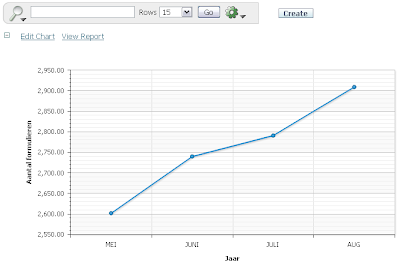The 4.2.1 version has much cooler features, as saving to image or to pdf with the right click menu. It also looks better and more organized. Why are normal flash chart regions still using 3.3? Well, probably because the XML source definition has changed! With APEX release 4.0 I think we can use Anycharts 4 with normal regions (Could be 3.2 but I think they have their hands full with Forms2Apex)
So what are we to do? While waiting is an option, trying to hack into Anycharts 4 is way much more fun! First some background info!
Read More!
Anycharts 3 & APEX architecture
Anycharts3 is using an .swf file for almost every different type of chart (and can be found in the /i/flashcharts directory). For every chart an .xml file has to be provided with the specific layout and data properties. Here's where APEX kicks in, the xml definition is generated by a procedure that is called APEX_UTIL.flash (Who's in charge off naming things over there at the APEX Dev Team?). There are some parameters provided, like the APP_ID, PAGE_ID, SESSION etc. More important is this parameter: FLOW_FLASH_CHART_R#REGION_ID#. And it's more important because it provides the apex_util.flash procedure with the region ID where you defined all your settings in a Charts Region (Like labels an colors). This ID is probably used in the procedure to get these values, and use them to generate a xml definition.
The resulting xml from apex_util.flash is parsed on a HTTP request! Just like any other page, the chart just shows the xml definition as a text/xml content type in your browser if you put the reference in the URL. This reference (with absolute path) looks like this: http://10.0.0.1:8080/pls/apex/apex_util.flash?p=105:8:985557025495156:FLOW_FLASH_CHART_R5188815604017627_en-us
In anycharts 3 the path is added as a parameter called XMLFile (remember that one) and is passed to the swf flash file.

Anycharts 4 & APEX Architecture
In Anycharts 4, all different types of charts are collected in one .swf file. This is again, combined with an xml definition file, telling how to layout the chart and what data is in there. The anycharts 4 xml files are different from the anycharts 3 xml files, because it has a different buildup. The anycharts 4 xml file is also generated from APEX! The procedure taking care of this is APEX_UTIL.flash2 (Honestly, who's in charge of naming, common!! ;) ). It is also called from the page object, but this time it is different. It is passed in the "flashvars" parameter as "XMLFile=http://10.0.0.1:8080/pls/apex/apex_util.flash2?p=etc. etc"
And this time, the XML defines what type of chart it is ! Not the flash file! So this adds great flexibility to developers!

Using anycharts 4
There are several ways to use anycharts 4. Here's what I was able to do:
- Create anycharts 4 from anycharts 3 region (but has some drawbacks)
- Reference an anychart 4 chart from an interactive report
- Create your own definition and put it in the images directory
- Create your own definition and reference it trough a procedure (just like APEX_UTIL.flash2)
Why not change the APEX_UTIL.flash procedure to APEX_UTIL.flash2? That's also the first thing I was thinking. But you have to make some more adjustments.
- Create a chart region with the APEX wizards
- Just create a normal HTML region
- Check out the code of the chart region at runtime (with Firebug offcourse)
- Copy the code between the OBJECT tags (include the
- Cut the swf variables ?XMLFile=etc. to the Flashvars param (and remove the "?")
- Change the APEX_UTIL.flash to APEX_UTIL.flash2

2. Reference an anychart 4 chart from an interactive report
If you create a chart in an interactive report, you can reference this in a HTML region. Changes made in the IR are also changed in the chart. If you want a dynamic anycharts 4 chart, this is a great way to do it!
- Create an interactive report
- Create a chart in the IR
- Save it as default!
- Copy the code below
- Paste it into a HTML region
- Change the parameters in the XMLFile parameter (page 6 is where the IR was, so change that to the page that your IR is)


3. Create your own definition and put it in the images directory
You can also just skip the APEX generation bit, and create your own XML file. You just have to reference it in the code for the swf file.
- Just create an XML file with for example the following code:
2601
2739
2790
2908
2925
2465
2231
2426
2231
2101
2084
2685
Title
<br><br /><br><text><br>Aantal formulieren</text><br><br /><br>
<br><br /><br><text><br>2008</text><br><br /><br>
{%Name}{enabled:False} {%FValue}{enabled:False}
- Next put the file in your /i/ directory
- Just copy the previous OBJECT code
- Reference your xml file in the XMLFile parameter as /i/yourxml.xml instead of the APEX_UTIL.flash2 string

4. Create your own definition and reference it trough a procedure
Now for the really interesting one! And this requires some additional settings. But what if you could just work the same way APEX works, with a packaged procedure, referenced in the URL (APEX_UTIL.flash2). But now we want to define our own procedure, which parses AnyChart 4 XML instead of 3, but now we can control it ourself! (Unlike flash2).
- Create a package (like "anycharts_xml_generator")
- Create a procedure in this packaged with a parameter XMLCallData number(like "procedure simple_xml(XMLCallDate IN NUMBER DEFAULT NULL)")
- Put in the following body
procedure p_simple_xml(p_param IN number default null, XMLCallDate IN number default null) IS
BEGIN
owa_util.mime_header('text/xml', FALSE, 'utf-8');
owa_util.http_header_close;
htp.p('');
htp.p('
<br /> <text>Sales of ACME Corp.</text><br />
<br /> <text>Sales</text><br />
<br /> <text>Retail Channel</text><br />
');
END;
- Next you need to make this procedure callable, so go to the FLOWS030100 schema
- Go to the Function WWV_FLOW_EPG_INCLUDE_MOD_LOCAL
- Add the "ANYCHART_XML_GENERATOR.SIMPLE_XML" to the following piece of code:
if upper(procedure_name) in (
'ADD_AS_A_FRIEND', 'ANYCHART_XML_GENERATOR.P_SIMPLE_XML') then
return TRUE;
else
return FALSE;
end if;
- The above code makes sure that you can call the procedure from the URL
- Next we need to change the reference for the XMLFile in the HTML region.
- Change the XMLFile parameter to:
http://yourIP:port/pls/apex/anychart_xml_generator.simple_xml?p_param=void
* Thanks to Mario Jozak, who pointed out to me that there HAS to be a parameter present, because the XMLCallDate is pasted as "&XMLCallDate" to the call. If this was the only parameter you will get an IO Error because the call would look like "p_simple_xml?&XMLCallDate" which is wrong! So thanks again, to Mario. - Run the page!

Final thoughts
As you can see, Anycharts 4 is a huge improvement over 3.0, not only on the visual side, but also with the functionality and flexibility it gives.
With the 4th way to get AnyCharts 4, it is is possible to create a Anycharts 4 generator, just like APEX_UTIL.flash2. So if some of the charts just aren't good enough for you, you can create them yourself!
Let me know, if you start using Anycharts 4, as I'm currently checking if I can create a generator!

4 comments:
Rutger,
what I know of the AnyChart guys provide an integration kit for Oracle APEX 3.1 which uses the new AnyChart 4 for the normal APEX chart regions. It's some kind of special flash file which will do the translation of the different XML formats.
Maybe that's an easier way to use the new and fancy version
patrick
There's already something coming ;-)
I'll just wait 4 more nights then :)
@Patrick, I would be surprised if they can manage the interfacing with different parameters and settings for anycharts 4 with a flash file. Then again, most of the time people keep surprising me :)
4 more nights.... I just can't stand waiting :)
Believe me, it works! I tried it when 3.1 came out. Sure you can't use any new settings because it just translates the one APEX offers on the UI, but at least it has the new look and feel. I think someone on the forum wrote about it recently.
OOW coming closer :-)
Post a Comment